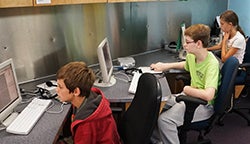Scientists are always looking for the newest and best way to fly higher, faster and farther. Last week, the University of Oregon helped a group of local students put their science knowledge to the test and released their inner rocketeer.
As part of the Science Factory’s inaugural “Fundamentals of Rocketry” summer camp, the UO Center for Science, Technology, Engineering and Math Careers through Outreach, Research, & Education program, also known as STEM CORE, worked with the UO Science Library to help 9- to 11-year-old students create rocket nose cones.
“STEM CORE sent out a call for ideas for programs promoting the next generation science standards and training opportunities for UO students interested in teaching,” said Dean Walton, UO science librarian. “We have a new 3-D printer at the science library and thought it would be great to work on a curriculum using that technology.”
The nose cones were designed using a computer-aided design program with the help of STEM-CORE, which also provided materials and scholarship funding for campers with financial need. After designing their nose cones, the students were able to print them on the science library’s 3-D printer. On Aug. 21 and 22, the students actually test launched their various nosecone designs at the Science Factory and collected data to verify each rocket’s performance.

“When you show the students how the physics and design works, their eyes light up,” said Walton. “The 3-D printer is an empowering tool when used with a CAD program and we gave these students the tools and experience to now go on and start designing on their own.”
The camps’ instructor, Ben Wright, is a UO alumnus who earned his degree in physics and is currently working toward his teaching credentials through the UOTeach Program offered by the Department of Education Studies in the College of Education.
Helping with outreach projects like this one at the “Fundamentals of Rocketry” summer camp is part of STEM CORE’s mission, which looks to enhance science, technology, engineering and math education, outreach and research and recruit math and science majors to K-12 teaching.
“With projects like this one, STEM CORE is promoting new partnerships involving a variety of UO resources and expertise with community organizations, schools, teachers and students,” said Bryan Rebar, associate director of STEM CORE. “The strategy involves seeding promising activities and collaborations in order to position these pilot projects for growth. We hope collaborative initiatives like the rocketry program continue grow and impact more students.”
—By Melissa Foley, Public Affairs Communications

